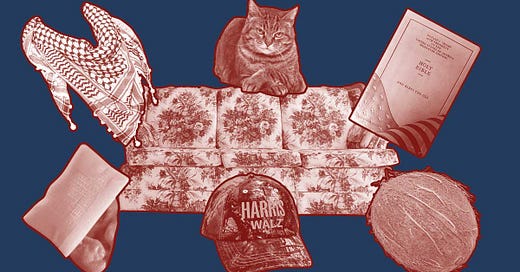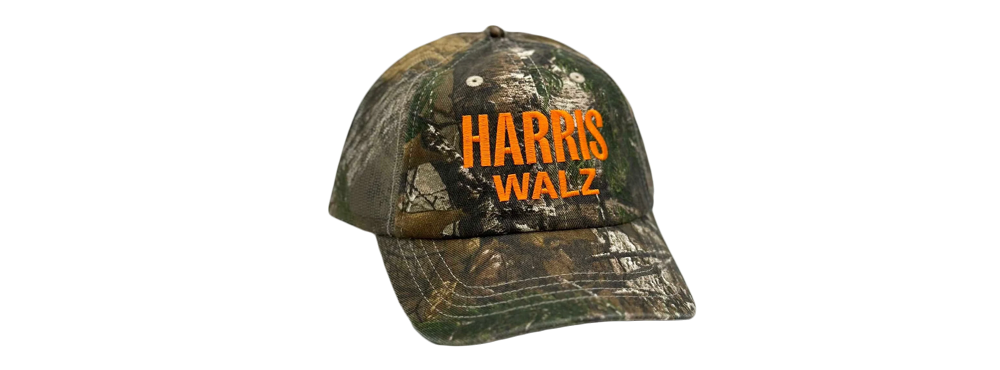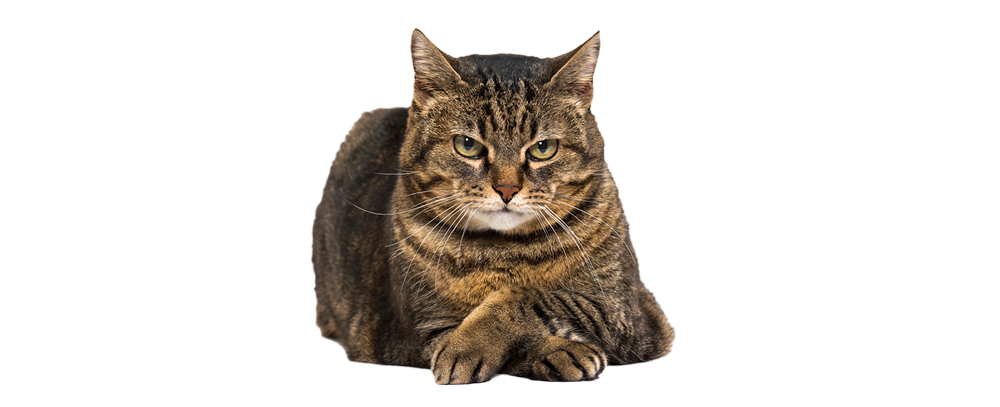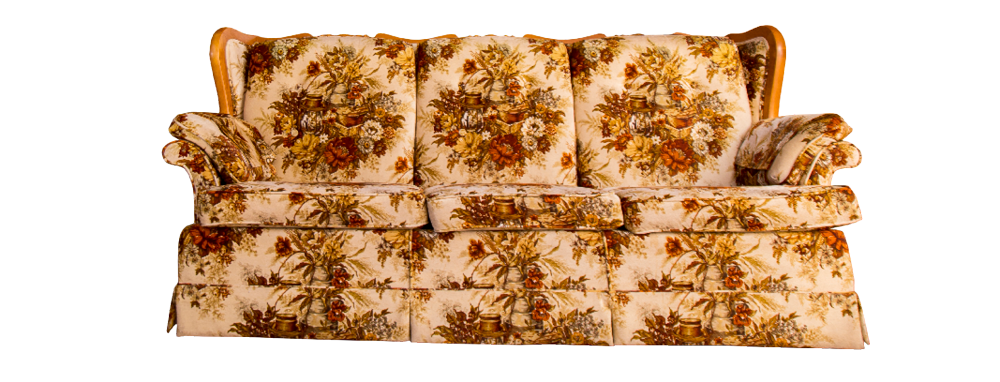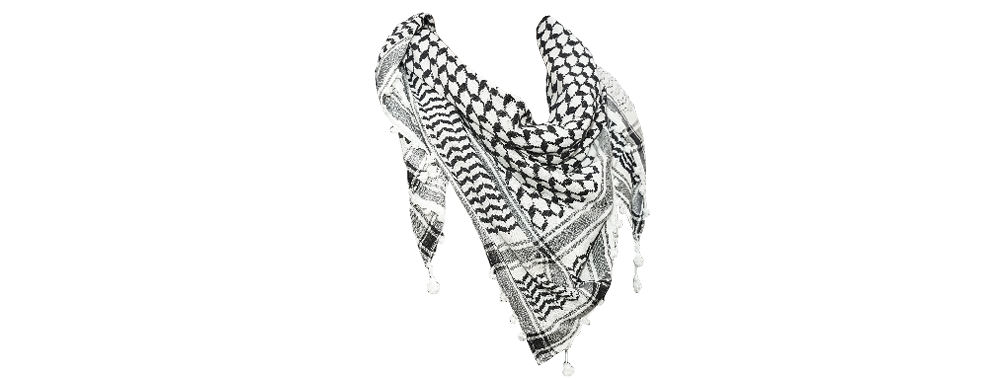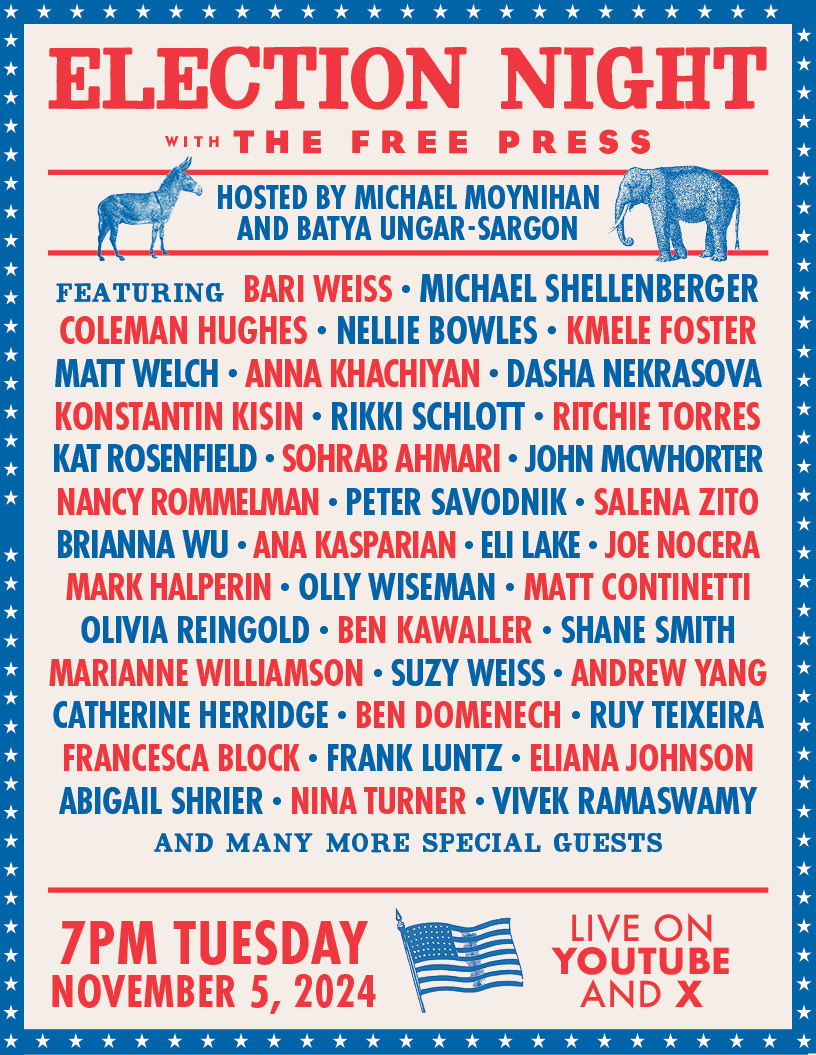
The Free Press

The most physically imposing picture of Donald Trump is the one he almost didn’t survive. You’ve seen it: The former president stands silhouetted against the sky, fist pumped, jaw jutted, bright red blood streaked across his face like war paint. The blood is from a bullet that missed its mark; the blood means that Trump should be dead, but isn’t. He’s still standing, all six-plus feet and 200 pounds of him, in the flesh, as corporeal as it gets.
In the wake of the assassination attempt, many commentators declared the election over. That raised fist, that frayed ear, the way Trump’s top teeth bore down on his lower lip as he shouted his defiance: It was powerful. It was undeniable. You’d never see Joe Biden standing up like that after taking a bullet in front of a crowd of thousands.
The image of Trump was symbolic, iconic, and instantly viral. Within 24 hours, it had appeared on the front page of virtually every newspaper in the world—by which time millions of people had made it their social media avatars and memed it into oblivion. It adorned miniskirts, coffee cups, and balaclavas; supporters displayed it in their homes and tattooed it onto their bodies. Most importantly, the assassination attempt caused a bump for Trump in swing states; if he wins the presidency, it will be at least in part because of that photograph.
But while that image of Trump may be the most powerful symbol of this insane race, it’s not the only one. Like the coconut emoji that became synonymous with Kamala Harris’s campaign. Or the cats beloved by liberal women (or, allegedly, eaten by immigrant hordes). These and more have been nominated by our staff as symbols of the 2024 election. Read on for the list of (mostly) inanimate objects that we’ll never see the same way again. —Kat Rosenfield
Suzy Weiss says: The Coconut
“I don’t know what’s wrong with you young people. You think you just fell out of a coconut tree?”
It was the remark that spawned a thousand memes. Uttered in May 2023 at the kind of White House ceremony we totally ignore, by a vice president we also totally ignored, it was followed by this equally nonsensical chestnut: “You exist in the context of all in which you live and what came before you.”
Then, two months later, Kamala Harris was running for president, and suddenly these comments were going viral. The whole world saw the Queen of Word Salad for what she is. And what did the Harris campaign do? It leaned in.
Coconuts and coconut trees were folded up into this summer’s Brat-themed social media campaign to get Kamala elected—not just by her fans, but by the actual Democratic Party. Important endorsements came in the form of coconut emojis; the bio of the campaign’s official X account still reads “Providing context.” Getting “coconut-pilled” became shorthand for giving in to Kamala as the Democrats’ candidate.
The coconut translates to “How I Learned to Stop Worrying and Love the Kam.” It represents a Democratic campaign that, having ditched one candidate for making no sense, decided to amplify his replacement’s nonsense.
If you’ve already forgotten what “Brat” is, remind yourself with the guide we published earlier this summer: “No, Kamala Harris Is Not ‘Brat.’ ”
Joe Nocera says: The Trump Bible
P. T. Barnum is credited with saying that there’s a sucker born every minute, but has anyone embraced that maxim quite the way Donald J. Trump has?
His entire career has been predicated on suckering people into buying his less-than-honest products, going back to his first autobiography, The Art of the Deal, which his ghostwriter, Tony Schwartz, now acknowledges is “an unintended work of fiction.” America has been offered Trump steaks (one review reads: “nothing but grease”); Trump University (one former employee said: “It was a facade. A total lie”); Trump’s $100,000 “Swiss-made” watches (CNN found: “linked to a shady strip mall in Wyoming”).
And during this election campaign, he’s still found time to peddle Trump sneakers, Trump silver coins, and Trump NFTs. But there is one product he has hawked that outraged the Trump-deranged more than all others—one that might have given even ol’ P.T. himself pause: the Trump Bible.
The official name of the Trump Bible, which he began pitching in March, is the God Bless the USA Bible. It is “inspired” by country singer Lee Greenwood’s song of the same name. It includes the text of the Constitution, the Declaration of Independence, and the Pledge of Allegiance. He’s wrapping himself in the flag and God in one $60 book! The special limited edition, which includes Trump’s signature, is $1,000. Also, the print is very large; Trump knows who his suckers, I mean, customers, are.
Now, the chances that Trump has ever studied a Bible verse are slim to none—something he’s proven whenever he’s been asked to recite something from the Good Book. He’s clearly forgotten the part in the Gospel According to John, where Jesus throws the wheeler-dealers out of the temple and says, “Stop making My Father’s house a place of business.”
He once told the American public the Bible is “my favorite book. . . nothing beats the Bible, not even The Art of the Deal, not even close.” It’s easy to understand why Trump would like it so much, even if he hasn’t read it: There is no copyright, meaning he didn’t have to pay anyone to reprint it, not even King James himself. And as of this summer, it had made him a cool $300,000, according to a federal financial form he published in August. Because when there’s money to be made for Donald Trump, even God can’t get in the way.
Read Joe Nocera’s latest piece: “I Have Trump Derangement Syndrome.”
River Page says: The Harris-Walz Camo Cap
The vice president’s stepdaughter, Ella Emhoff, is neither rural nor Southern. She grew up in an upper-middle-class family in Los Angeles and is now a “multidisciplinary artist” in Brooklyn, who mostly knits socks. But there she was at the DNC wearing a camouflage baseball cap with “HARRIS WALZ” emblazoned in orange. Rolling Stone tweeted a picture of the 25-year-old model, commenting that her stepmother’s merch was “genius”—and linking to a piece that opined: “The camouflage hat reclaims the rural and Southern identity that mainstream Democrats have long ignored.”
The camo hats—which sold out within 30 minutes upon its release on the Harris-Walz webstore, netting nearly $1 million for the Harris campaign—were made for girls and gays, not deer-hunting rednecks in Alabama. They are actually a nod to pop singer Chappell Roan, a lesbian and self-proclaimed “drag queen” who sells a nearly identical hat on her own website, except the slogan is “Midwest Princess,” in reference to her hit album The Rise and Fall of a Midwest Princess.
There’s been an attempt by the Democrats this election cycle to embrace Americana: “Democrats Are Reclaiming the Flag—and It’s About Time,” reads this recent headline from The Hill. Kamala has insisted on calling her running mate “Coach Walz” to highlight his former job running a high school football team. A more offline person might assume that the camo hat is yet another on-the-nose attempt by the Democrats to relate to middle America, but, like Kamala’s staffers, I’m chronically online enough to know the truth.
Kamala’s camo hat is meant to appeal to people who know what Chappell Roan merch looks like—people who, almost by definition, would have voted for Kamala Harris anyway. It follows the Harris campaign’s embrace of the Brat aesthetic, inspired by British musician Charli XCX’s album of the same name. As a member of the target audience for this sort of thing, I must ask: How many gay guys do Democrats think there are in this country?!
River is just as skeptical of the Republican Party’s appeal to the working class. Read his piece: “How Rednecks Like Me Hear J.D. Vance.”
Kat Rosenfield says: A Cat
Unlike some of the other symbols in our roundup, cats have the distinction of being distinctly bipartisan. On the left, savvy culture warriors responded to J.D. Vance’s ill-advised snark about “childless cat ladies” with an explosion of pro-cat enthusiasm: festooning their cars with “Cat Ladies for Kamala” bumper stickers, creating a bespoke cat-themed version of the Gadsden flag, and writing in their cats for State Comptroller (okay, maybe that last one was just me).
But if cat imagery became the new “pink pussy hat,” a symbol of Trump-deranged Democratic hysteria, cats also became a talisman for an equally unhinged contingent of Trump-loving MAGA Republicans—albeit for different reasons.
Folks in this camp evidently don’t think much of cats when they’re owned by liberal female voters. But they will stop at nothing to protect those same cats from the clutches of ravenous Haitian migrants who want to turn poor Mr. Fluffy into a hamburger. (Narrator: No actual cats were harmed in the making of this bizarre urban legend.)
Whether they’re adorning a T-shirt at the DNC or sizzling on a barbecue in Trump’s most nightmarish fantasies, there’s no doubt that cats are the ultimate vehicle for the political anxieties of both sides. They’re the perfect cause to champion, whether you’re voting Demo-cat or Re-purrr-blican.
For more on America’s national conversation about cat ladies, read Kat’s piece: “What the Childless Among Us Leave Behind.”
Oliver Wiseman says: J.D. Vance’s Couch
On July 24, the Associated Press published a “fact check” article with the headline: “No, J.D. Vance Did Not Have Sex with a Couch.” It was one of many moments during this election when sane, normal Americans, of all political affiliations, asked themselves: What the hell is going on?
If you’ve blocked the couch-schtupping saga out of your mind, allow me to refresh your memory. Shortly after Vance was announced as Trump’s running mate, a random guy made up a joke detail from Vance’s memoir: “Can’t say for sure but he might be the first vp pick to have admitted in a ny times bestseller to fucking an inside-out latex glove shoved between two couch cushions (vance, 𝘩𝘪𝘭𝘭𝘣𝘪𝘭𝘭𝘺 𝘦𝘭𝘦𝘨𝘺, pp. 179-181),” posted “@rickrudescalves” on X.
Crass, kind of funny, the sort of thing you might laugh at before exiting the app and getting on with your day. Except that’s not what happened. The possibility that J.D. Vance maybe had sexual relations with that piece of furniture became A Thing. The Harris campaign itself joined in the fun, referencing it on its official X account. At a rally, Tim Walz said, “I can’t wait to debate [Vance]. That is, if he’s willing to get off the couch and show up.” The crowd loved it; Harris, standing next to Walz, smirked. “You see what I did there?” added the Minnesota governor, in case anyone had missed what he did there. The couch joke was briefly so ubiquitous that there were almost certainly a good number of Democrats who thought this was true—or at least might be true.
Then came the AP “fact check.” “At no point in his memoir does Vance write about performing sex acts on a couch,” clarified the AP. Thanks. (The AP eventually took down the article because it “didn’t go through our standard editing process” before publication.)
The couch symbolizes a few things. The terminally online nature of so much of this race, especially the Harris campaign. (Preorder my campaign trail book, From Brat to Garbage, now.) The Democratic strategy to combat Vance with school playground tactics, by painting him as “weird.” The unfortunate reality that people will believe anything if they want it to be true. And the futility of anti-misinformation “fact check” journalism.
In other words, the stupidity of it all.
Olly’s been thinking a lot about the weirdly gendered memes of this election. Read his piece: “Kamala the Brat vs. Trump the Macho Man.”
Peter Savodnik says: The Bandage
Two days after he was shot, Donald Trump arrived at the Republican National Convention in Milwaukee wearing a white patch over his right ear. Immediately, Trump supporters started doing the same, in solidarity. You can still—for $18.99—buy a “Trump 2024 Ear Bandage” on Amazon. The product description claims that it represents “a shared moment of healing and remembrance.”
Deep MAGA loved it, because The Bandage connected them with Orange Jesus in a visceral and even primitive way. His pain was theirs. His blood was their blood. His near-death was their near-death. They were bound together forever. It was transcendent. It was Christian—sort of.
We are accustomed to our politicians wrapping themselves in God. George W. Bush opening his Office of Faith-Based and Community Initiatives. Barack Obama constantly invoking Jesus, the better to ward off fears that he was a closet Muslim. Hillary Clinton sharing that story about getting her daily 5 a.m. jolt of Scripture.
But the Bandage was not about wrapping oneself in God. It was about merging with Him. Fusing one’s suffering with His. Which is why many of the serious Christians I spoke with at the convention seemed a little put off by it. Though a disproportionate number of Arizona delegates sported the Bandage, it was less popular in more socially conservative states.
After all, God can’t be seen or touched. He exists beyond the empirical. He is a force and a goodness that cannot be contained in any physical form, and The Bandage—that went too far, as far as they were concerned. “We wear the cross,” one delegate from Tennessee told me. “We don’t climb onto a cross and pretend to be the son of God.”
For a taste of Peter Savodnik’s transcendent reporting from this election, read: “The Abandoned Americans.”
Olivia Reingold says: The Keffiyeh
Our fact-checker had a note.
On October 8, 2023, I wrote up my report on the first anti-Israel rally I ever covered, in which I’d described the black-and-white checked scarves worn by so many protesters. “I think you’re talking about keffiyehs,” she’d written.
Since then, keffiyehs have become ubiquitous. You see them on front desk receptionists, other subway riders, and baristas. They’ve become a little protest slipped into the everyday—a sartorial statement to say, “Yes, I am checking you in at your doctor’s office but I’d be out on the streets, screaming outside a synagogue if I could.” They’ve become the uniform of young progressives—more often than not found beading bracelets for Palestine on Ivy League campuses—who may help Trump win the election.
This past August, outside the Democratic National Convention, keffiyeh-wearers told me how the party they once belonged to now consists of “murderers,” “genociders,” “terrorist white supremacists,” and “imperialist pigs.” Activists encircled the conference while holding up signs with the faces of Harris, Biden, and Trump slithering on snake bodies. “Different heads,” the posters declared in black block letters, “same beast.”
Will the keffiyeh-wearers bring the Democratic Party to its knees for the sake of Gaza, or will they return home to the party that raised them once they’re alone in the safety of the ballot box? Election Day will test whether they mean what they say—that “Killer Kamala” and Trump are so indistinguishable that they’re both worth eschewing.
To read Olivia’s report on the Democrats who did decide to embrace Kamala Harris, click here: “Ridin’ with Biden Is Now KHive or Die.”
And if you want to hear more from this incredible array of Free Pressers, you can tune in to our election livestream at 7 p.m. on Tuesday evening.
Click this link and select “notify me”: YouTube will let you know the moment the show starts. Or you can watch it on X. You don’t want to miss this.
For more coverage of the 2024 election, click here.
And to support our independent journalism mission, subscribe to The Free Press today:

